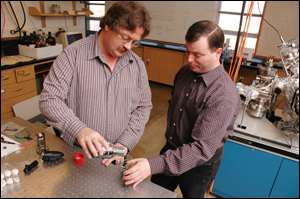OSU researchers develop detection test for hydrogen peroxide-based explosives
Friday, August 11, 2006

Oklahoma State University researchers who have developed a method to diffuse TATP and HMTD chemically can also detect the peroxide-based explosives simply and immediately.
Typically homemade and extremely volatile, TATP and HMTD reportedly were to be used in the terrorist plot foiled on Aug. 10 by British authorities.
A compound developed by Allen Apblett and Nick Materer, faculty members in OSU’s chemistry department, undergoes a chemical reaction and changes color in the presence of TATP or HMTD. Applied and allowed to dry on plastic sticks resembling those used by people with diabetes to test blood, it detects the explosives within seconds. As importantly, the compound can sense hydrogen peroxide in any liquid if someone attempts to bring the primary ingredient for TATP and HMTD onto a plane to mix with other bomb ingredients once on board.
TATP (triacetone triperoxide) and HMTD (hexamethylene triperoxide diamine) are mixtures of highly concentrated hydrogen peroxide and other common chemicals. However, once the ingredients are combined, the resulting explosives are volatile. According to Materer, the accidental deaths of several bomb-makers in the Middle East have kept TATP or HMTD from becoming widely popular among terrorist groups. Nevertheless, the bombs used in the murder of 52 people on London’s transit systems on July 7, 2005, were hydrogen peroxide-based. TATP and HMTD were detailed in the Aug. 10 report the FBI and Department of Homeland Security released to law enforcement agencies warning of their potential use in future attacks.
Apblett and Materer have been working on chemical neutralizing hydrogen peroxide-based explosives for more than four years. Initially funded by the Memorial Institute for the Prevention of Terrorism in Oklahoma City, they developed and demonstrated a method to spray or coat explosives with a compound that causes their chemical deactivation. An outgrowth of that research is the detection test, which is a recent development. The professors have begun to explore the patenting of the concept and are in discussions with a manufacturer.
